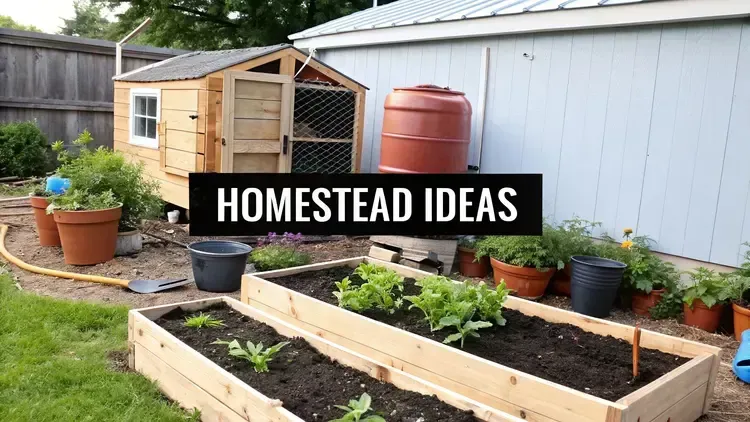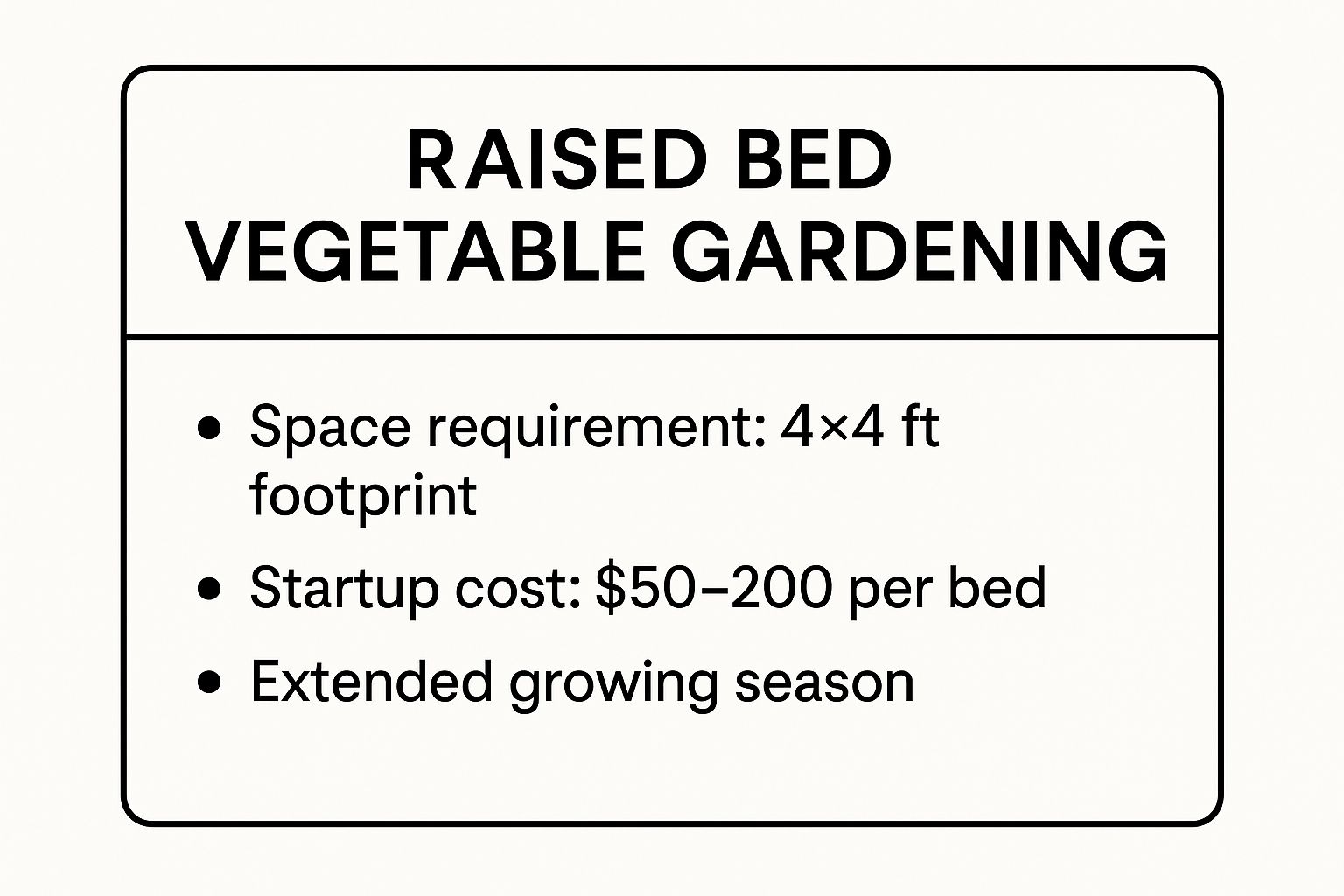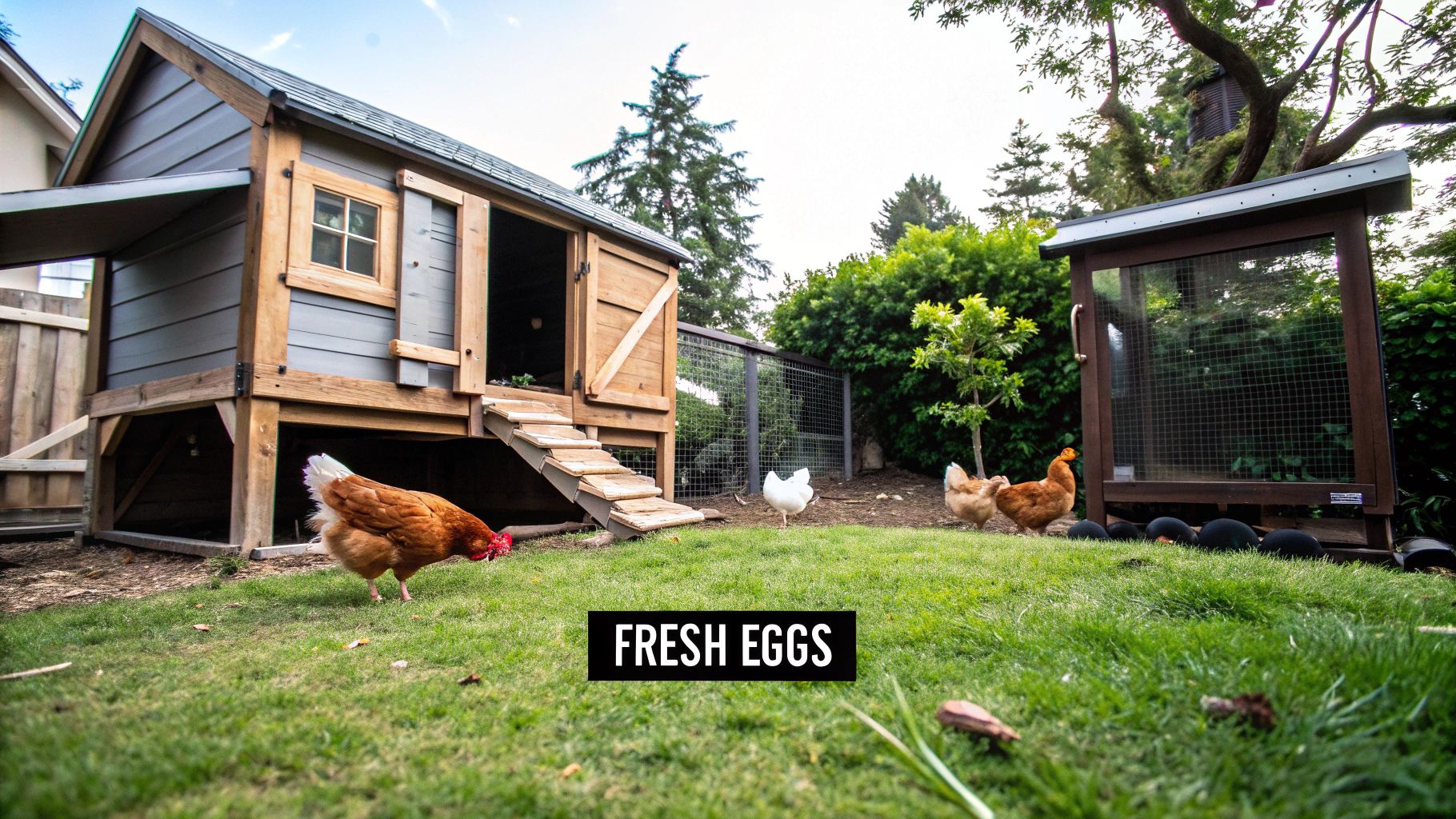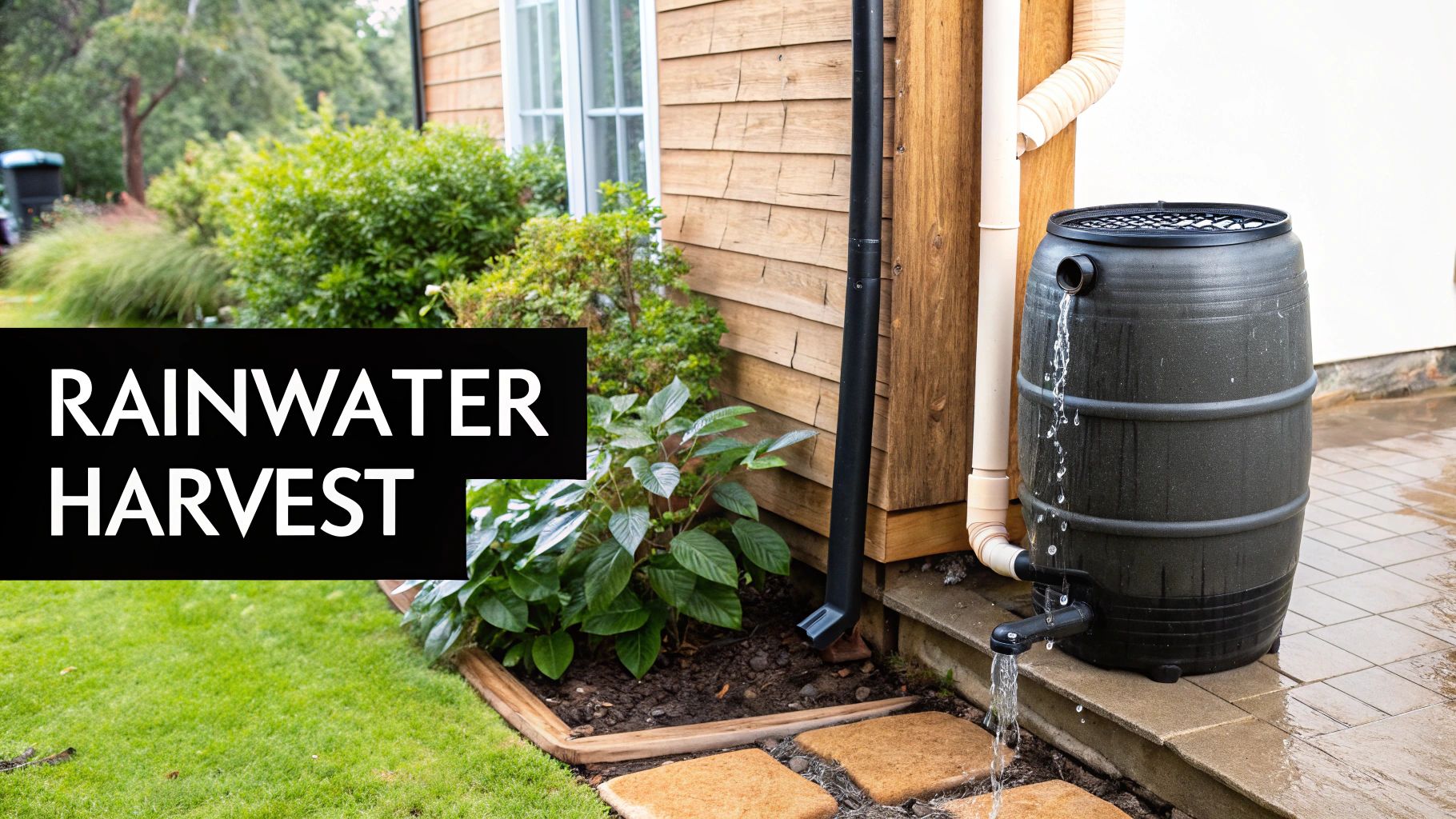
9 Backyard Homesteading Ideas for 2025: A Practical Guide
9 Backyard Homesteading Ideas for 2025: A Practical Guide
9 Backyard Homesteading Ideas for 2025: A Practical Guide
Transform Your Yard into a Thriving Homestead
1. Raised Bed Vegetable Gardening
7. Small Livestock Integration
Your Homesteading Journey Begins Now
Charting Your Course: Practical Next Steps
Transform Your Yard into a Thriving Homestead
Imagine stepping into your backyard to harvest fresh vegetables, collect eggs from your own hens, and feel a deep connection to your food source. This isn't a distant dream reserved for rural acreages; it's the accessible reality of modern backyard homesteading. As more people seek healthier lifestyles and greater self-sufficiency, turning small urban and suburban spaces into productive ecosystems has become an empowering movement. This guide moves beyond the obvious to explore nine transformative backyard homesteading ideas, providing actionable steps and the practical knowledge needed to start your journey.
Whether you have a tiny patio or a quarter-acre lot, these projects are designed to maximize your space and help you build a more sustainable life, right where you are. We will cover everything from foundational skills like composting and raised bed gardening to more integrated systems like aquaponics and fruit tree guilds. Each idea is presented as a manageable project, ensuring there is a clear starting point for everyone, regardless of experience level. Prepare to get your hands dirty and discover the immense satisfaction of creating your own personal homestead.

1. Raised Bed Vegetable Gardening
One of the most foundational backyard homesteading ideas is raised bed vegetable gardening. This method involves growing plants in contained frames filled with a high-quality soil mix, elevated above the existing ground. This approach is perfect for urban homesteaders with poor native soil, renters who can't dig up the yard, or anyone seeking better control over their growing environment. It solves common problems like soil compaction, poor drainage, and weed infiltration, making it an efficient way to maximize food production in a small footprint.
Key Benefits and Implementation
The primary advantage of raised beds is complete control over the soil. Instead of battling clay or sand, you can create the perfect loamy blend from scratch. This leads to healthier plants and higher yields. Accessibility is another major benefit; raised beds can be built to a comfortable height, reducing the strain of bending and kneeling. This makes gardening more enjoyable and accessible for people of all ages and physical abilities.
For successful implementation, follow these tips:
Sizing: Construct beds no wider than 4 feet. This ensures you can easily reach the center from either side without stepping on and compacting the soil.
Materials: Use naturally rot-resistant, untreated wood like cedar or composite materials. Avoid pressure-treated wood manufactured before 2003, as it may contain harmful chemicals.
Soil Mix: A popular and effective recipe is "Mel's Mix," popularized by Mel Bartholomew: one-third compost, one-third peat moss or coco coir, and one-third coarse vermiculite. This mix provides nutrients, retains moisture, and stays light and airy.
Watering: Install a drip irrigation or soaker hose system on a timer for consistent, efficient watering that directs moisture to the plant roots and minimizes waste. You can even grow thirsty plants like lettuce with remarkable success using this targeted approach.
The following infographic provides a quick reference for the typical investment and benefits of a standard raised bed.

As the data shows, a modest initial investment can yield significant returns by enabling an extended growing season, maximizing a small space for years to come.
2. Backyard Chicken Keeping
One of the most rewarding backyard homesteading ideas is raising a small flock of chickens. This practice brings the farm-to-table experience directly to your home, providing a daily supply of fresh, nutrient-dense eggs. It involves setting up a secure coop and run for a small group of hens, typically 3 to 6, which is an ideal number for consistent egg production without overwhelming a residential space. This venture connects you directly to your food source and offers a fantastic educational opportunity for the whole family.

Key Benefits and Implementation
The most obvious benefit is the daily harvest of superior-tasting eggs with deep, golden yolks. Beyond the eggs, chickens are excellent at pest control, eagerly devouring insects and slugs. Their droppings, when composted, become a nitrogen-rich "black gold" fertilizer for your garden, creating a closed-loop system of sustainability. The simple joy and routine of caring for a flock also provide a unique form of stress relief and connection to nature.
For a successful implementation, consider these essential tips:
Check Local Laws: Before you do anything else, thoroughly research your local zoning ordinances and HOA rules regarding poultry. Many urban areas have specific limits on flock size and may prohibit roosters.
Coop and Run Space: Provide adequate room for your flock to thrive. A good rule of thumb is at least 4 square feet of coop space per bird and a minimum of 10 square feet of run space per bird.
Predator Proofing: Your top priority is security. Use 1/2-inch hardware cloth instead of chicken wire on all openings, as raccoons can easily tear through wire or reach through larger gaps. Ensure all latches are secure and predator-proof.
Daily Care: Establish a simple routine of providing fresh food and water, collecting eggs daily to ensure freshness and prevent broodiness, and performing a quick flock health check.

3. Composting Systems
Creating your own "black gold" through composting is a cornerstone of sustainable backyard homesteading ideas. This process transforms organic waste like kitchen scraps and yard trimmings into a nutrient-dense soil amendment, closing the loop on your household's resource cycle. By diverting waste from landfills, you not only reduce your environmental footprint but also produce a free, high-quality fertilizer that revitalizes garden soil. From simple piles to advanced bioreactors, there is a composting method suitable for every space and commitment level.
Key Benefits and Implementation
The most significant benefit of composting is soil enrichment. The finished product improves soil structure, aeration, and moisture retention while providing a slow-release source of vital plant nutrients. This reduces the need for synthetic fertilizers and helps build a resilient, living soil ecosystem. Composting also significantly cuts down on household garbage, turning what was once trash into a valuable resource for your homestead.
For successful implementation, follow these tips:
Balance Your Greens and Browns: Aim for a carbon-to-nitrogen ratio of roughly 3:1. "Browns" (carbon) include dried leaves, straw, and cardboard, while "greens" (nitrogen) are kitchen scraps, fresh grass clippings, and coffee grounds.
Maintain Moisture: Your compost pile should feel like a wrung-out sponge. It needs to be consistently moist but not waterlogged to support the microorganisms doing the decomposition work.
Aerate the Pile: Turning the pile with a pitchfork every one to two weeks introduces oxygen, which accelerates the breakdown process and prevents smelly, anaerobic conditions.
Chop It Up: Smaller pieces of organic matter have more surface area, allowing microbes to break them down much faster. Chop up large vegetable stalks or run over leaves with a lawnmower.
Choose a Method: For beginners, a simple tumbler or bin is effective. Apartment dwellers can use a worm bin (vermicomposting), while those seeking a low-maintenance, high-quality output might explore the Johnson-Su bioreactor method.
For a simple and expandable compost solution that works in almost any backyard, the Marcytop compost tumbler is one of the best budget-friendly options around.
4. Rainwater Harvesting
Among the most impactful backyard homesteading ideas is rainwater harvesting, a practice of collecting and storing runoff from roofs and other surfaces. This ancient technique provides a free, sustainable source of soft, chlorine-free water ideal for irrigating gardens and even for certain household uses with proper filtration. Systems can range from a simple rain barrel connected to a downspout to more complex cisterns, offering resilience against drought and reducing reliance on municipal water supplies, thereby lowering utility bills.

Key Benefits and Implementation
The primary benefit of rainwater harvesting is water security and conservation. By capturing this valuable resource, you create a buffer for dry spells, ensuring your garden thrives without straining local water systems. This practice is so effective that it's encouraged through municipal incentives in places like Austin, Texas, and is even mandatory for new construction in regions like Bermuda. Author and permaculture expert Brad Lancaster has been a key advocate, popularizing techniques that turn a home into a productive, water-wise ecosystem.
For successful implementation, follow these tips:
Container Safety: Always use food-grade barrels or tanks to avoid chemical contamination. Ensure they are opaque to prevent algae growth.
Filtration: Screen all inlets with fine mesh to keep out leaves, debris, and mosquitoes. A first-flush diverter is crucial, as it redirects the initial, often contaminated, wash of rainwater from the roof.
Stable Placement: Position your barrels on a level, stable platform like cinder blocks. Elevating the barrel increases water pressure for easier use with a hose.
Overflow Management: Connect multiple barrels with overflow pipes to maximize storage capacity. Direct the final overflow away from your home's foundation to prevent water damage.
Implementing a rainwater harvesting system is a powerful step towards creating a more self-sufficient and resilient backyard homestead.
To get started without complicated plumbing, this rain barrel and diverter kit connects right to your downspout and includes everything you need for basic rain capture.
5. Fruit Tree Guilds
A more advanced yet incredibly rewarding backyard homesteading idea is creating fruit tree guilds. This permaculture technique involves planting a community of beneficial plants around a central fruit tree to form a self-sustaining mini-ecosystem. Instead of simply planting a tree in a lawn, a guild integrates companion plants that fix nitrogen, deter pests, attract pollinators, and accumulate minerals from the subsoil, creating a resilient and productive system that mimics a natural forest edge. This method reduces maintenance while increasing the overall health and yield of your fruit tree.
Key Benefits and Implementation
The main advantage of a fruit tree guild is its synergistic design. Each plant serves multiple functions, contributing to the health of the central tree and the surrounding soil. This creates a low-input, high-output system that eliminates the need for chemical fertilizers and pesticides. It's an efficient way to stack functions in a small space, producing not just fruit but also herbs, flowers, and other edible crops in the same footprint.
For successful implementation, follow these tips:
Start Small: Begin with a single fruit tree. Establish a guild around it before expanding to a full "food forest." This allows you to learn the principles on a manageable scale.
Plant Layers: A classic guild includes several layers. For an apple tree, this might mean planting nitrogen-fixing goumi berries, pest-repelling chives and garlic near the trunk, mineral-accumulating comfrey, and a ground cover like clover.
Choose Companions Wisely: Research plants compatible with your chosen fruit tree and climate. Include nitrogen-fixers (clover, beans), pest deterrents (marigolds, alliums), and pollinator attractors (bee balm, yarrow).
Mulch Heavily: Apply a thick layer of wood chips or straw around the guild. This suppresses weeds, retains moisture, and feeds the soil food web as it decomposes. You can also integrate low-growing edibles like strawberries as a living mulch, a concept you can explore further to see how permaculture principles can be applied to strawberries for enhanced growth.
6. Vertical Growing Systems
For homesteaders with limited horizontal space, the only way to go is up. Vertical growing systems are a game-changing backyard homesteading idea that uses trellises, stacked containers, and towers to cultivate plants upward. This approach dramatically multiplies your growing area without expanding your ground footprint. It is ideal for small patios, balconies, or any compact yard where maximizing every square inch is critical. Techniques range from simple DIY pallet gardens and trellises to sophisticated aeroponic towers, making food production possible in even the most constrained urban environments.
Key Benefits and Implementation
The most significant advantage of vertical growing is its incredible space efficiency. A single tower garden can grow dozens of plants in the same footprint a single large container would occupy. This method also improves air circulation around plants, which can reduce the incidence of fungal diseases. Furthermore, harvesting is often easier, as many crops are at a more accessible height, similar to the ergonomic benefits of raised beds.
If you're short on space but want big results, this 5-tier vertical planter from Mr. Stacky lets you grow dozens of herbs or greens in a single compact footprint—perfect for patios, balconies, or small gardens.
For successful implementation, follow these tips:
Structural Support: Ensure your system is stable and well-anchored. Tall structures can become top-heavy and susceptible to wind, so secure them to a wall, fence, or a weighted base.
Sunlight: Consider how the sun moves across your yard. Rotate towers periodically if needed, and place sun-loving plants on the sunniest side of a vertical wall.
Plant Selection: Choose plants that suit this style. Vining crops like cucumbers and pole beans are natural climbers. Leafy greens, strawberries, and herbs thrive in the smaller pockets of tower and wall systems.
Watering: Gravity is your friend. Install a drip irrigation system at the top of your structure, allowing water to trickle down efficiently through each level, ensuring consistent moisture from top to bottom with minimal waste.
7. Small Livestock Integration
One of the most transformative backyard homesteading ideas is integrating small livestock. This practice involves raising animals like rabbits, quail, or miniature goats in a backyard setting to produce meat, eggs, or milk. Beyond just providing food, these animals can become a core part of your homestead's ecosystem. They are perfect for suburban homesteaders who lack the acreage for larger animals, offering a sustainable source of protein and other products while contributing to land management.
Key Benefits and Implementation
The primary advantage of small livestock is their efficiency in small spaces. Unlike cows or full-sized goats, many smaller species can thrive in a typical backyard, converting feed and garden scraps into valuable resources like nutrient-rich manure for your compost. For instance, a "rabbit tractor" (a mobile, bottomless cage) can be moved across your lawn daily, providing the rabbit with fresh forage while fertilizing the grass. Similarly, a small flock of ducks is renowned for its ability to control slugs and other garden pests naturally.
For successful implementation, follow these tips:
Zoning Laws: Before acquiring any animals, thoroughly research and comply with your local municipal and HOA regulations regarding livestock. Many urban areas have specific rules about species, numbers, and coop placement.
Start Small: Begin with just one species that fits your goals and space. Quail, for example, are an excellent starting point as they mature quickly and require minimal room.
Predator-Proof Housing: Invest in secure, well-built housing. Raccoons, hawks, and even neighborhood dogs can be significant threats, so sturdy locks and hardware cloth are non-negotiable.
Plan Daily Care: Animals require consistent daily attention for feeding, watering, and health checks. Establish a firm routine before they arrive. This consistent care is just as crucial as building a low-maintenance strawberry setup for your garden.
8. Aquaponics Systems
For the homesteader looking to maximize efficiency and production, aquaponics systems represent one of the most innovative backyard homesteading ideas. This method creates a symbiotic, closed-loop ecosystem by combining aquaculture (raising fish) with hydroponics (growing plants without soil). Fish waste, rich in ammonia, is converted by beneficial bacteria into nitrates, which serve as a powerful natural fertilizer for the plants. In turn, the plants' roots absorb these nutrients, cleaning and filtering the water before it returns to the fish tank. This elegant process produces both protein and fresh produce with minimal waste and water usage.
Key Benefits and Implementation
The core benefit of aquaponics is its incredible resource efficiency. It uses up to 90% less water than traditional soil gardening and completely eliminates the need for synthetic fertilizers. The system is self-sustaining, providing a continuous harvest of both fish and vegetables. You can grow a surprising amount of food in a small area, making it ideal for urban or suburban backyards. Popularized by pioneers like Will Allen of Growing Power, these systems can range from simple DIY IBC tote conversions to more sophisticated commercial setups.
For a successful aquaponics system, consider these critical factors:
System Ratio: Maintain a proper balance between your fish tank volume, grow bed area, and fish stocking density. A common starting point is a 1:1 ratio of fish tank volume to grow bed volume.
Fish Selection: Start with hardy, fast-growing fish that tolerate a range of conditions, such as tilapia or even ornamental goldfish. They are forgiving for beginners while the system establishes itself.
Bacteria Colony: The beneficial bacteria are the heart of the system. Allow your system to "cycle" for 4-6 weeks before adding many plants to establish a robust bacterial colony that can convert ammonia to nitrates.
Monitoring: Regularly test water parameters. Daily checks for pH and ammonia are crucial, especially in a new system, to prevent levels that could harm your fish.
This video provides a great visual overview of how a basic backyard aquaponics system functions.
By carefully managing these elements, you can create a highly productive food system that is both fascinating to operate and bountiful in its harvests.
9. Herb Spiral Gardens

An incredibly efficient and beautiful addition to any homestead is the herb spiral. This permaculture design involves creating a three-dimensional, spiral-shaped garden bed that cleverly establishes multiple microclimates within a very small footprint. By building vertically, it creates a gradient of sun exposure and moisture levels, allowing you to grow a diverse range of herbs with different needs side-by-side. This is one of the most productive backyard homesteading ideas for maximizing both space and biodiversity.
Key Benefits and Implementation
The primary benefit of an herb spiral is its resource efficiency. The design naturally channels water from the top, which is drier, down to the bottom, which remains moister. This allows sun-loving, drought-tolerant herbs to thrive at the top while water-loving plants flourish at the base. The spiral shape also significantly increases the available planting area and edge space compared to a flat, circular bed of the same diameter, boosting overall productivity.
For successful implementation, follow these tips:
Optimal Sizing: Construct the spiral to be about 6 feet in diameter and 3 feet high at its center. This size provides enough variation in microclimates while keeping all plants easily accessible.
Material Selection: Use locally sourced, natural materials like stone, brick, or untreated wood logs to build the spiral wall. Recycled materials are a great, sustainable option.
Strategic Planting: Place Mediterranean herbs that prefer dry, sunny conditions (like rosemary, thyme, and oregano) at the top. Plant moisture-loving herbs (like mint and parsley) at the bottom.
Soil and Drainage: Fill the spiral with a good quality soil mix rich in organic matter. You can add extra gravel or sand to the top section to enhance drainage for the plants that need it.

Your Homesteading Journey Begins Now
Embarking on the path of modern homesteading transforms your backyard from a simple patch of grass into a dynamic, productive, and deeply satisfying ecosystem. Throughout this guide, we've explored a spectrum of powerful backyard homesteading ideas, each one a stepping stone toward greater self-reliance and a deeper connection to your food. You now have a practical roadmap for turning your vision into a reality.
The beauty of this journey is that it’s not an all-or-nothing endeavor. The most successful and sustainable homesteads are built incrementally, project by project, season by season. The key is to avoid overwhelm and start with what genuinely excites you and aligns with your available resources, whether it's space, time, or budget.
Charting Your Course: Practical Next Steps
The transition from inspiration to action is the most critical step. Instead of trying to tackle everything at once, focus on a single, manageable project to build momentum and confidence.
For the Absolute Beginner: Start with a foundational project like a composting system or a single raised bed for vegetable gardening. These projects have a low barrier to entry, provide quick, tangible results, and teach you fundamental principles of soil health and plant care that will serve you in all future endeavors.
For the Gardener Seeking to Expand: If you already have a garden, consider adding a new layer of productivity. Installing a rainwater harvesting system to reduce your water bill or building a vertical growing system to maximize a small footprint are excellent next steps. These projects integrate with what you already have, making your existing space more efficient.
For the Aspiring Homesteader: If you’re ready for a bigger commitment, exploring backyard chicken keeping or designing a fruit tree guild can be incredibly rewarding. These more advanced projects create closed-loop systems where different elements of your homestead begin to support one another, reducing waste and increasing overall resilience.
The True Value of Backyard Homesteading
Mastering these concepts is about more than just growing food. It’s about cultivating resilience, reducing your environmental footprint, and gaining invaluable hands-on skills. Each successful harvest, every jar of preserved food, and every fresh egg collected is a powerful reminder of your capability. This journey empowers you to create a more secure, sustainable, and nourishing life, right in your own backyard.
Remember, every expert was once a beginner. The most important thing is to simply begin. Choose your first project from the backyard homesteading ideas we've covered, get your hands dirty, and embrace the process of learning and growing.
Video Summary of this issue:
As always, the tools and supplies I mention are the same ones I rely on here at The Grounded Homestead. Some are affiliate links, which means I may earn a small commission—at no extra cost to you—but every recommendation is based on real use and trust.
Ready to take your homesteading skills to the next level with expert guidance and a supportive community? At The Grounded Homestead, we provide in-depth courses, practical blueprints, and a wealth of resources designed to help you build a thriving, productive homestead. Join us to turn your backyard dreams into a sustainable reality. Subscribe to our weekly newsletter, "Garden Notes," is packed with tips and stories to guide you every step of the way.



Facebook
Instagram
X
Youtube